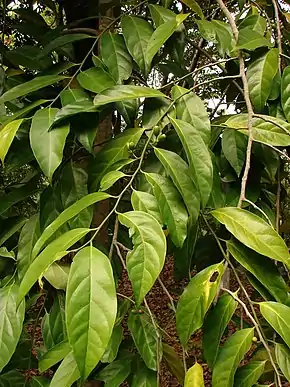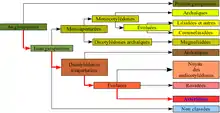Stemonuraceae
La famille des Stemonuraceae est une famille de plantes dicotylédones.
Stemonuraceae

Gomphandra australiana
Voir le texte pour plus d'information.

| Clade | Angiospermes |
|---|---|
| Clade | Dicotylédones vraies |
| Clade | Astéridées |
| Clade | Campanulidées |
| Ordre | Aquifoliales |
Étymologie
Le nom vient du genre type Stemonurus, composé des mots grecs στήμων / stimon (latin stāmen), « fil ; étamine », et ουρά / oura, « queue d’animal », littéralement « étamines en forme de queue ».
Classification
En classification classique de Cronquist (1981)[1] cette famille n'existe pas.
La classification phylogénétique APG II (2003)[2] et classification phylogénétique APG III (2009)[3] acceptent cette famille. Elle comprend des plantes classiquement assignées à la famille Icacinacées.
Liste des genres
Selon Angiosperm Phylogeny Website (12 nov. 2015)[4] :
- Cantleya (en) Ridl.
- Codiocarpus (es) R.A.Howard
- Discophora (en) Miers
- Gastrolepis (en) Tiegh.
- Gomphandra (en) Wall. ex Lindl.
- Grisollea (en) Baillon
- Hartleya Sleumer
- Irvingbaileya (sv) R.A.Howard
- Lasianthera P.Beauv.
- Medusanthera (sv) Seem. GG
- Stemonurus (en) Blume
- Whitmorea (en) Sleumer
Selon NCBI (12 nov. 2015)[5] :
- Discophora
- Gomphandra
- Grisollea
- Irvingbaileya
- Lasianthera
- Medusanthera
Selon ITIS (12 nov. 2015)[6] :
- Stemonurus
Liste des espèces
Selon NCBI (12 nov. 2015)[5] :
- genre Discophora
- Discophora guianensis
- genre Gomphandra
- Gomphandra australiana
- Gomphandra javanica
- Gomphandra mappioides
- Gomphandra quadrifida
- Gomphandra tetrandra
- genre Grisollea
- Grisollea myrianthea
- genre Irvingbaileya
- Irvingbaileya australis
- genre Lasianthera
- Lasianthera africana
- genre Medusanthera
- Medusanthera laxiflora
Notes et références
- (en) Arthur Cronquist, An Integrated System of Classification of Flowering Plants, New York, Columbia University Press, (ISBN 0-231-03880-1, OCLC 1136076363, lire en ligne)
- (en) Angiosperm Phylogeny Group, « An update of the Angiosperm Phylogeny Group classification for the orders and families of flowering plants: APG II », Botanical Journal of the Linnean Society, Wiley-Blackwell, Linnean Society of London et OUP, vol. 141, no 4, , p. 399–436 (ISSN 0024-4074 et 1095-8339, DOI 10.1046/J.1095-8339.2003.T01-1-00158.X)
- (en) Angiosperm Phylogeny Group, « An update of the Angiosperm Phylogeny Group classification for the orders and families of flowering plants: APG III », Botanical Journal of the Linnean Society, Wiley-Blackwell, Linnean Society of London et OUP, vol. 161, no 2, , p. 105–121 (ISSN 0024-4074 et 1095-8339, DOI 10.1111/J.1095-8339.2009.00996.X)
- Stevens, P. F. (2001 onwards). Angiosperm Phylogeny Website. Version 14, July 2017 [and more or less continuously updated since]." will do. http://www.mobot.org/MOBOT/research/APweb/, consulté le 12 nov. 2015
- NCBI, consulté le 12 nov. 2015
- Integrated Taxonomic Information System (ITIS), www.itis.gov, CC0 https://doi.org/10.5066/F7KH0KBK, consulté le 12 nov. 2015
Liens externes
- (en) Référence Madagascar Catalogue : Stemonuraceae
- (en) Référence Angiosperm Phylogeny Website : Stemonuraceae ()
- (en) Référence NCBI : Stemonuraceae (taxons inclus)
- (fr+en) Référence ITIS : Stemonuraceae
- (en) Référence GRIN : famille Stemonuraceae Krehed (+liste des genres contenant des synonymes)
- Portail de la botanique
Cet article est issu de Wikipedia. Le texte est sous licence Creative Commons - Attribution - Partage dans les Mêmes. Des conditions supplémentaires peuvent s'appliquer aux fichiers multimédias.